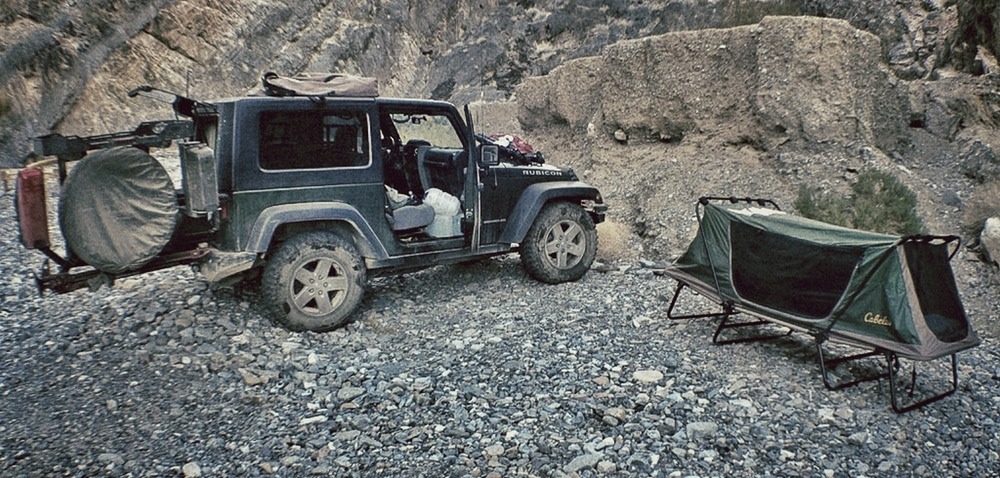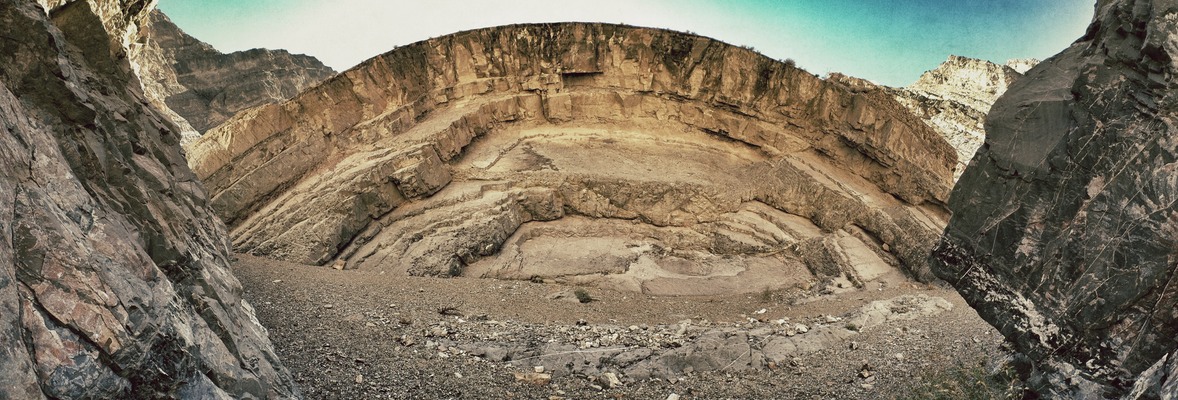
Away from civilization, an overnighter was called for at Red Rock Canyon State Park before the final trek into Death Valley and Marble Canyon's extended exploration. This was not to be an adventure - adventures are what you get when your explorations go wrong. Something went wrong. Upon arrival, it was obvious the weather did not bode well for the efficacy of the trip. The sky was bright blue and clear, temperatures in the low 90's, low humidity. A wonderful climate for anything other than hiking and photography.

The eight mile loop out of Ricardo Campground into the raptor nesting grounds of Nightmare Gulch and onto the Red Rock Canyon OHV trail is a peaceful hike, with the photo opportunities minimal this time out. The photographs that made the cut were ones that show the isolated, serene yet arid & hostile, land that is the Mojave. Given the very clear skies and very low humidity, the heavens, however, were open to interpretation. The set of forty-second exposures with a 15mm fisheye show it for what it is, a sky of stars and galaxies that populate the Milky Way to full bloom.
The next day began the trek into Marble Canyon, deep inside Death Valley and the Cottonwood Mountains. The several hour drive from Red Rock Canyon, past Ridgecrest and China Lake Naval Air Weapons Station, through both Searles and Panamint valleys, then down into Death Valley proper for a fuel top off at Stove Pipe Wells, was uneventful and scenic. After another hour drive up the alluvial fan entrance to the Cottonwood back country, thru the canyon slot, and up the righthand wash at the street sign, I arrived at the 1700' entrance to Marble Canyon. Like Red Rock Canyon, Marble Canyon was equally beautiful. Again, the sky was bright blue and clear, temperatures in the low 90's, low humidity. Even at 1700' the temperature was still in the low 90's - matching that in Stove Pipe Wells at 10' elevation. The 10° temperature decrease every 1000' rule was less of a rule, and more of a desire on this trip. The other bit of fun was that the already low humidity was a tad lower at elevation compared to the valley floor. More on that later.
The day still had light available, so the plan was to scope out the well trod lower parts of the canyon and hike, minimally, to the upturned swimming pool rock structure. The plan for the next day was to pack in for an overnight or two up on the top of Dead Horse Canyon. That was the plan. A good plan. A planned-for plan with all of the necessities for the hike in and back. The plan changed. The afternoon excursion up to the dry fall at the sideways pool was a good, yet very dry, hike.

Much water was used in the excursion, while little food was consumed. Turns out when humidity is very low - lower than 10% - it is hard to eat anything dryish like Steve's Original PaleoKit or Primal Pacs. Even with the injected apple juice, these jerky packs were simply hard to eat with a dry mouth. The short 2.5 mile round trip, an easy 360' elevation gain from 1700' to 2060', demonstrated the futility of an inspiring time to be had partaking of the planned plan for a one or two night stay on top of Dead Horse Canyon, a 6 mile hike one way to the canyon mouth, another 4 miles up the canyon looking for water (it is there year round, just need to find it), in the very dry heat and blue sky clarity flooding the land with unobstructed sunlight.

The next day would not be a day of packing in, but rather a day of hiking to the mouth of Dead Horse Canyon - that was the minimum amount of trekking that must be done, if nothing but for the sake of knowing the hike to that point. The twelve mile round trip hike up Marble Canyon was quite enjoyable, if not hot and dry. Starting around 7am, just after sunrise, the hike up canyon was generally cool in temperature, a tad moist in air, and comfortable in climb up the dry wash. Passing through the longest portion of marble in Marble Canyon, there was visible moisture along the edge of the dry river wash. The air smelled strongly of water with a sort of dry moisture marble taste. The moisture in the air was quite refreshing and interesting, except for the fact that this manifestation of the marble canyon was much like the interestingness of seeing the water along a beach wash far out into the distance. There just had to be a downside.

After the final mile uphill along the dry wash to 3125' (a 1425' elevation gain for those who know their maths), the left-hand fork that was Dead Horse Canyon was reached. To the right went Marble Canyon, and is where I sought out shade in the slot of the canyon. It was now mid-day, the sun high overhead and moisture wicking out of the air. Off to the left was the beginning of Dead Horse Canyon - the goal of this little jaunt. Was it now worth the effort to hike up this wide and well exposed canyon to look for the pot of gold that is the year round spring? Or call it, having made the photograph of the split in the road, showing again the isolated, serene yet hostile & arid, land that is the Mojave. I walked up canyon all of ten feet, see there was nothing but hot and dry as far as the land would reveal, decide enough was enough, and made back for camp, looking forward to the cool moist air of the long marble canyon portion of the ride.

About that cool moist air of the long marble canyon portion of the ride. Turns out there is indeed a downside to the cool moist air goodness from the earlier part of the day. Turns out that marble, by its very nature, releases moisture when cool, and absorbs it when warm. Once the sun hit the walls of the long tall narrow marble canyon, the moisture in the air was all sucked back into the rock, turning this portion of the ride home, while very interesting, very uncomfortable. As the day was already well under 10% humidity, this part of Marble Canyon was that much lower again. So much so that taking a breath through the nose was at best painful, and a mouth breath dried your tongue to cracking. Lots of water consumption was required walking down thru this stretch of the wash, and though a bit peckish, food was simply not going to be had. There was simply no way to chew food to the point of being able to swallow; it was more like chewing to a powder and mixing with a mouth full of water, then attempting to swallow. Once of that was enough. Rejuvenative nourishment was going to have to wait until well past the Zero Humidity Zone. Okay, so not nearly as worrisome as a tide being pulled out to sea, but an environmental anomaly that was nonetheless interesting and unexpected.

The remaining several miles downhill to camp were uneventful, making good time and back before dark or the liquid of life had run out. Of the five liters of water starting out, only three fourths of a liter remained. At camp the temperature was nearly the same as it was mid-day up canyon, and the air was just as dry. A wonderful climate for anything other than hiking and photography.
Rather than continued exploring after three days in the desert fun, the camera had decided it was time to let the desert turn to sea.
The drive from camp at Marble Canyon to Morro Bay is nine hours. Two leisurely hours to get out of Cottonwood Mountain to Stove Pipe Wells, and seven hours to Morro Bay. A welcome sight driving out of Paso Robles thru Atascadero was the fog rolling over the mountains of Cuesta Grade. Once in Morro Bay, the change in climate allowed the camera to flourish: A Great Egret taking flight, the colors of the morning sun on a quiet bay, a juvenile Snowy Egret inspecting his new world from sunrise to sunset, a Brown Pelican feeding frenzy and a family of California mule deer, a Great Blue Heron attempting to ignore the goings on of the his feathered friends, miscellaneous shore birds feeding at low tide, a very patient Peregrine Falcon dancing between the trees, and colorful sunsets through the fog and over the bay.
A successful adventure.